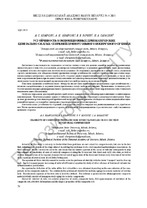| dc.contributor.advisor | | |
| dc.contributor.author | Кравчук, А. С. | ru |
| dc.contributor.author | Кравчук, А. И. | ru |
| dc.contributor.author | Кочик, Е. В. | ru |
| dc.contributor.author | Тарасюк, И. А. | ru |
| dc.coverage.spatial | Минск | ru |
| dc.date.accessioned | 2018-09-18T10:17:05Z | |
| dc.date.available | 2018-09-18T10:17:05Z | |
| dc.date.issued | 2015 | |
| dc.identifier.citation | Устойчивость композиционных призматических центрально-сжатых стержней прямоугольного поперечного сечения / А. С. Кравчук [и др.]. // Весцi Нацыянальнай акадэмii навук Беларусi. Серыя фiзiка-тэхнiчных навук. – 2015. – № 4. – С. 54-60. | ru |
| dc.identifier.uri | https://rep.bntu.by/handle/data/47626 | |
| dc.description.abstract | Актуальность настоящего исследования состоит не только в том, что данные задачи не решены для композиционных тел, но и в том, что, к сожалению, несмотря на большой интерес к решению данного типа задач, до настоящего времени остались методические неточности их решения. Исследования, проведенные в данной статье, позволили сделать заключение, что общеизвестному уравнению потери устойчивости соответствуют только две схемы закрепления концов центрально-сжатого вдоль оси 0х стержня: двумя закрепленными по оси 0y концами, а также верхним закрепленным (конец приложения силы) и нижним свободно перемещающимся концом с дополнительным условием равенства нулю производной уравнения изогнутого нейтрального слоя в нижней точке. Известное уравнение устойчивости по Эйлеру не может быть использовано для решения задач устойчивости с нижним «защемленным», и верхним (конец приложения силы) свободным концами. Применяемое во многих работах повышение порядка дифференциального уравнения для обоснования иных схем закрепления не имеет никакого математического обоснования. Получено выражение для первой критической силы в зависимости от концентрации компонент в композиционном материале. Получено решение задачи устойчивости для однородно стареющего вязкоупругого материала. Определено уравнение релаксации первой критической нагрузки. Данное решение обобщено на композиционный неоднородный материал, состоящий из однородно стареющих вязкоупругих материалов. | ru |
| dc.language.iso | ru | ru |
| dc.publisher | Беларуская навука | bel |
| dc.subject | Устойчивость стержней | ru |
| dc.subject | Вязкоупругие свойства твердых тел | ru |
| dc.subject | Композиционные тела | ru |
| dc.subject | Приближение Хилла кривизны композиционного стержня | ru |
| dc.subject | Stability of rods | en |
| dc.subject | Viscoelastic properties of solids | en |
| dc.subject | Composite body | en |
| dc.title | Устойчивость композиционных призматических центрально-сжатых стержней прямоугольного поперечного сечения | ru |
| dc.title.alternative | Stability of composite prismatic rod of rectangular cross-section at central compression | en |
| dc.type | Article | ru |
| local.description.annotation | Actuality of this study is not only in the fact that these problems are not solved for composite rods, but also in the fact that, unfortunately, despite of the huge interest in solving this problems it was still remained methodological inaccuracies in their solutions. Studies carried out led to the conclusion that the known equation of the losses of stability corresponds to only two schemes of constraints of ends of centrally compressed along the 0x axis rod: two fixed-ends in 0y direction, as well as fixation in 0y direction of the top end (it means the rod end of application of the force) and fixation in 0y direction of derivative of the equation of neutral layer of rod at the bottom end. The equation of Euler stability cannot be used to solve the problems of stability with the lower "clamped" and the free top ends. Applied in many papers increasing of order of differential equation for study of other schemes of fixation of rod ends has no mathematical justification. An equation for definition of the value of the first critical force was obtained depending on the concentration of the components in the composite material. The solution to the problem of stability for uniform aging viscoelastic material of rod was hold. The relaxation equation of the first critical load was defined. This solution is generalized to inhomogeneous composite material which consists of homogeneously aging viscoelastic components. | en |

